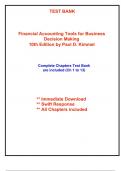TEST BANK
Financial Accounting Tools for Business
Decision Making
10th Edition by Paul D. Kimmel
Complete Chapters Test Bank
are included (Ch 1 to 13)
** Immediate Download
** Swift Response
** All Chapters included
, CHAPTER 1
INTRODUCTION TO FINANCIAL STATEMENTS
CHAPTER LEARNING OBJECTIVES
1. Identify the forms of business organization and the uses of accounting information. A
sole proprietorship is a business owned by one person. A partnership is a business owned by
two or more people associated as partners. A corporation is a separate legal entity for which
evidence of ownership is provided by shares of stock. Internal users are managers who need
accounting information to plan, organize, and run business operations. The primary external
users are investors and creditors. Investors (stockholders) use accounting information to
decide whether to buy, hold, or sell shares of a company’s stock. Creditors (suppliers and
bankers) use accounting information to assess the risk of granting credit or loaning money to
a business. Other groups who have an indirect interest in a business are taxing authorities,
customers, labor unions, and regulatory agencies.
2. Explain the three principal types of business activity. Financing activities involve
collecting the necessary funds to support the business. Investing activities involve acquiring
the resources necessary to run the business. Operating activities involve putting the
resources of the business into action to generate a profit.
3. Describe the four financial statements and how they are prepared. An income statement
presents the revenues and expenses of a company for a specific period of time. A retained
earnings statement summarizes the changes in retained earnings that have occurred for a
specific period of time. A balance sheet reports the assets, liabilities, and stockholders’ equity
of a business at a specific date. A statement of cash flows summarizes information
concerning the cash inflows (receipts) and outflows (payments) for a specific period of time.
Assets are resources owned by a business. Liabilities are the debts and obligations of the
business. Liabilities represent claims of creditors on the assets of the business. Stockholders’
equity represents the claims of owners on the assets of the business. Stockholders’ equity is
subdivided into two parts: common stock and retained earnings. The basic accounting
equation is Assets = Liabilities + Stockholders’ Equity. Within the annual report, the
management discussion and analysis provides management’s interpretation of the company’s
results and financial position as well as a discussion of plans for the future. Notes to the
financial statements provide additional explanation or detail to make the financial statements
more informative. The auditor’s report expresses an opinion as to whether the financial
statements present fairly the company’s results of operations and financial position.
*4. Explain the career opportunities in accounting. Accounting offers many different jobs in
fields such as public and private accounting, governmental, and forensic accounting.
Accounting is a popular major because there are many different types of jobs, with unlimited
potential for career advancement
, 1-2 Test Bank for Kimmel, Financial Accounting: Tools for Business Decision Making, 10e
Difficulties:
Easy: 143
Medium: 101
Hard: 12
Question List by Section
Business Organization and Accounting Information Uses:
Forms of Business Organization; 47, 48, 202, 246
Sole Proprietorship: 5, 44, 49, 58, 59
Partnership: 1, 4, 46, 56
Corporation: 2, 3, 45, 50, 51, 52, 53, 55, 57, 233, 245
Hybrid Forms of Organization: 60, 61
Users and Uses of Financial Information: 6, 7, 11, 74, 87
Internal Users: 62, 63, 64, 75, 77, 82, 234
External Users: 8, 9, 10, 12, 65, 76, 78, 79, 80, 81, 83, 84, 85, 86, 88, 89
Data Analytics: 66, 67, 68, 69, 70, 235, 236
Ethics in Financial Reporting: 71, 72, 73, 237, 255
The Three Types of Business Activity: 97
Financing Activities: 13, 15, 18, 90, 91, 93, 94, 95, 96, 97, 102, 109, 117, 118, 119, 238
Investing Activities: 14, 16, 98, 99, 115, 116
Operating Activities: 17, 19, 20, 100, 101, 103, 104, 105, 106, 107, 108, 110, 111, 112, 113,
114
The Four Financial Statements:
Income Statement: 21, 22, 23, 24,127, 128, 132, 133, 134, 138, 142, 143
Retained Earnings Statement: 120, 122, 123, 124, 125, 126, 129, 130, 131, 135, 137, 139, 140,
141, 144, 145, 146, 147, 148, 149, 150, 154, 164, 169, 178, 181, 252
Balance Sheet: 25, 27, 28, 29, 30, 31, 32, 33, 34, 35, 136, 151, 152, 153, 163, 165, 166, 168,
170, 173, 177, 179, 180, 182, 185, 186, 187, 188, 199, 200, 201, 207, 208, 213, 214, 215, 216,
217, 218, 219, 220, 221, 222, 225, 229, 239, 240, 241, 253
Statement of Cash Flows: 26, 121, 171, 174, 183, 242, 249
Interrelationships of Statements: 155, 156, 157, 158, 159, 160, 161, 162, 167, 175, 176, 184,
250, 251, 256
Elements of an Annual Report: 36, 41, 192, 196, 197
Management Discussion and Analysis: 40, 191
Notes to the Financial Statements: 37, 42, 190, 193, 194, 198, 254
Auditor’s Report: 38, 39, 195




